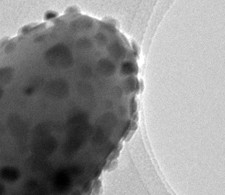Nano-catalyst key to solving 30-year-old bioplastic riddle

Matthijs Ruitenbeek senior scientist hydrocarbons R&D at Dow Benelux, told FoodProductionDaily.com the company had helped develop the catalyst, which consists of tiny iron spheres on a support material, along with researchers from the University of Utrecht and Delft University of Technology in the Netherlands.
The reseach was published by the journal Science in February 2012.
Bottleneck resolved
The catalyst is used in a three-step process that involves taking a feedstock – in this case agricultural waste – and converting it into what is known as a synthesis gas, which can then be transformed into the desired olefins to ultimately make a plastic.
The breakthrough it enables is to markedly increase the efficiency of the method by boosting the yield of the second step by slashing the amount of methane gas by-product, said Ruitenbeek.
“Until recently, there were too many steps involved in the process, so the technology was not efficient or economical enough to be used on a large scale,” added University Utrecht professor Krijn de Jong.
The new three-step process made possible by the catalyst removed this barrier, added Dr Ruitenbeek.
Polyethylene from biomass a step closer
Ruitenbeek said Dow would use the catalyst to focus on the manufacture of polyethylene, as the company is the largest producer of the polymer in the world.
“There are two ways to add a green flavour to polymers: one is to produce plastics from biobased feedstocks – such as PLA. Another way is to make existing plastics materials from renewable feed stocks. The focus of this project is on conventional plastic with a green feedstock,” he said. “This breakthrough is an important stepping stone towards the main goal of commercialising the production of plastics from biomass."
He explained that scientists had been struggling to overcome the difficult second step of the process for over 30 years. The patents which set the benchmark for the previous most efficient performance were filed in the mid-1970s.
Gap is closing
Ruitenbeek said the project was not yet producing polymers yet but that the present goal was to refine the process further to make it commercially viable.
“At present, the potential cost of plastics using this method remains more expensive than petroleum-based materials, but the gap is closing,” he said. “And we believe that as our research progresses and the cost of oil-based products rises in the long term, it will become cheaper.
“The advantage of this is that it delivers PE that is identical to petroleum-based material which means packaging converters and suppliers would be able to source sustainable plastic without having to change any of their processes.”
He estimated that a pilot plant was still a few years away and that the process would not be commercialised for between 5-10 years.
Science 17 February 2012: Vol. 335 no. 6070 pp. 835-838 DOI: 10.1126/science.1215614, Supported Iron Nanoparticles as Catalysts for Sustainable Production of Lower Olefins Hirsa M. Torres Galvis, Johannes H. Bitter, Chaitanya B. Khare, Matthijs Ruitenbeek, A. Iulian Dugulan, Krijn P. de Jong



